Lignin is a complex polymer found in plant materials. In the paper industry, lignin is unwanted as it lower paper’s quality and therefore must be removed. This extracted lignin is usually burned as a source of power to operate the paper mill. However, considering its chemical components and structure, lignin has potential to be turned into high-value chemicals.
As a result of the collaboration set out to explore lignin valorization, BIOTEC-NSTDA and KMUTT successfully developed an organosolv process that renders the paper-making processes more eco-friendly. Organosolv is a pretreatment process that employs organic solvents to extract lignin from biomass. Lignin recovered from this process has higher purity level and maintains several of its unique properties, including UV absorption ability and antioxidant effect, and therefore has potential to be developed into functional additives for a wide range of industrial applications, as explained by Dr. Chayanon Chotirotsukon, a researcher of Biorefinery and Bioproduct Technology Research Group.

The plastic industry plays an important role in Thailand’s economy with several thousand active producers in the supply chain. Benefits that lignin can contribute to this industry are significant, including value addition, cost reduction and creation of green products. Therefore, lignin utilization in the plastic industry became the initial focus of the research team.
Dr. Chayanon said that the team has studied the use of lignin to add functional properties to several types of plastic widely used in Thailand including polyethylene (PE), polypropylene (PP), high density polyethylene (HDPE), and linear low density polyethylene (LLDPE), in the forms of both petroleum-based and bioplastic. Lignin’s functional properties that have been investigated by the research team include its UV blocking property, its pigment and antioxidant effect. Lignin is a natural UV-blocking material and therefore can add an UV protection property to outdoor plastic furniture, as well as plastic food packaging to extend the shelf life of fresh produce. Brown pigment obtained from lignin can replace metal oxide-based colorants.

“Our latest achievement is the use of lignin as a functional additive in PLA filament, one of the most popular materials used in 3D printing,” added Dr. Chayanon. Enterprises interested to explore the functionalities of lignin is plastic products are welcome to use this 3D printing platform to test their ideas.
Industrial utilization of lignin not only adds value to waste from paper manufacturing and gives new functionalities to finished products, but the process also reduces carbon emissions. Burning lignin without a carbon capture and storage system to obtain energy results in the release of carbon, and thereby increasing carbon emissions. However, utilizing lignin as a functional additive is considered a carbon capture, usage and storage (CCUS) technology and thus its product thereof will have a lower carbon footprint which can benefit from carbon taxes and increase its marketing appeal.
This innovation exemplifies a complete process from lignin removal from one industry to lignin utilization in another industry and represents the concept of Bio-Circular-Green Economy (BCG) model.

